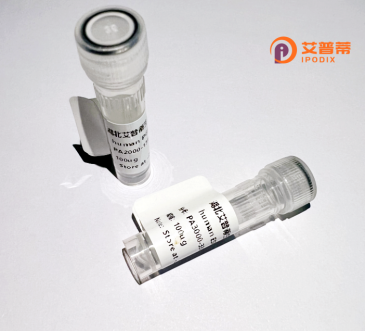
| 纯度 | >90%SDS-PAGE. |
| 种属 | Human |
| 靶点 | FAM126A |
| Uniprot No | Q9BYI3 |
| 内毒素 | < 0.01EU/μg |
| 表达宿主 | E.coli |
| 表达区间 | 1-521aa |
| 氨基酸序列 | MFTSEKGVVEEWLSEFKTLPETSLPNYATNLKDKSSLVSSLYKVIQEPQSELLEPVCHQLFEFYRSGEEQLLQFTLQFLPELIWCYLAVSASRNVHSSGCIEALLLGVYNLEIVDKQGHTKVLSFTIPSLSKPSVYHEPSSIGSMALTESALSQHGLSKVVYSGPHPQREMLTAQNRFEVLTFLLLCYNAALTYMPSVSLQSLCQICSRICVCGYPRQHVRKYKGISSRIPVSSGFMVQMLTGIYFAFYNGEWDLAQKALDDIIYRAQLELYPEPLLVANAIKASLPHGPMKSNKEGTRCIQVEITPTSSRISRNAVTSMSIRGHRWKRHGNTELTGQEELMEISEVDEGFYSRAASSTSQSGLSNSSHNCSNKPSIGKNHRRSGGSKTGGKEKETTGESCKDHFARKQTQRAQSENLELLSLKRLTLTTSQSLPKPSSHGLAKTAATVFSKSFEQVSGVTVPHNPSSAVGCGAGTDANRFSACSLQEEKLIYVSERTELPMKHQSGQQRPPSISITLSTD |
| 分子量 | 84 kDa |
| 蛋白标签 | GST-tag at N-terminal |
| 缓冲液 | 0 |
| 稳定性 & 储存条件 | Lyophilized protein should be stored at ≤ -20°C, stable for one year after receipt. Reconstituted protein solution can be stored at 2-8°C for 2-7 days. Aliquots of reconstituted samples are stable at ≤ -20°C for 3 months. |
| 复溶 | Always centrifuge tubes before opening.Do not mix by vortex or pipetting. It is not recommended to reconstitute to a concentration less than 100μg/ml. Dissolve the lyophilized protein in distilled water. Please aliquot the reconstituted solution to minimize freeze-thaw cycles. |
以下是关于重组人FAM126A蛋白的3篇代表性文献的简要信息:
1. **"Mutations in the gene encoding FAM126A cause hypomyelinating leukodystrophy"**
- **作者**:Volkova et al.
- **摘要**:研究发现FAM126A基因突变导致脑白质营养不良(HLD5),通过功能缺失实验表明该蛋白对中枢神经系统髓鞘形成至关重要,揭示其与细胞膜结构和胶质细胞功能的关联。
2. **"FAM126A interacts with HCCR and regulates cell proliferation and apoptosis in glioma"**
- **作者**:Yang et al.
- **摘要**:文章阐明了重组人FAM126A蛋白与人宫颈癌基因(HCCR)的相互作用,提出其通过调控PI3K/AKT通路影响胶质瘤细胞增殖和凋亡,提示其潜在的肿瘤治疗靶点价值。
3. **"Structural and functional characterization of FAM126A’s role in phosphatidylinositol 4-kinase complex"**
- **作者**:Zhang et al.
- **摘要**:通过晶体结构解析,揭示FAM126A作为磷脂酰肌醇4-激酶(PI4KIIIα)复合物的关键辅助因子,维持内质网膜稳态,并参与细胞膜重塑和信号传导的分子机制。
以上研究涵盖FAM126A的疾病关联、分子互作及结构功能机制,可供进一步研究方向参考。
Human FAM126A (family with sequence similarity 126 member A), also known as HYCC1. is a ubiquitously expressed protein encoded by the *FAM126A* gene located on chromosome 7p15.3. It plays a critical role in cellular membrane biology, particularly in the formation and maintenance of myelin sheaths in the central nervous system. FAM126A interacts with phosphatidylinositol 4-kinase type IIIα (PI4KIIIα) to regulate phosphatidylinositol 4-phosphate (PI4P) synthesis, which is essential for membrane trafficking and myelination. Mutations in *FAM126A* are associated with hypomyelinating leukodystrophy-5 (HLD5), a rare autosomal recessive disorder characterized by abnormal myelination, developmental delays, and neurological deficits.
Recombinant human FAM126A protein is engineered using heterologous expression systems (e.g., *E. coli* or mammalian cells) to study its molecular functions, structural properties, and interactions. It serves as a tool for investigating HLD5 pathogenesis, screening therapeutic agents, and developing diagnostic assays. Structural studies reveal conserved domains linked to its lipid-binding and protein interaction capabilities. Researchers also explore its broader roles in cell signaling, cytoskeletal organization, and potential involvement in other diseases, including cancer and metabolic disorders. Recombinant FAM126A aids in elucidating mechanisms of dysmyelination and offers insights into targeted therapies for leukodystrophies.
×